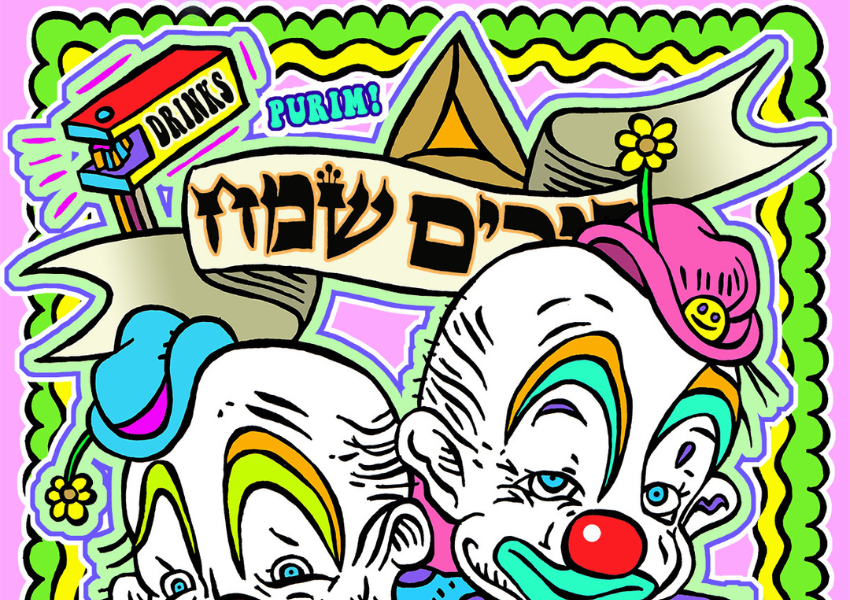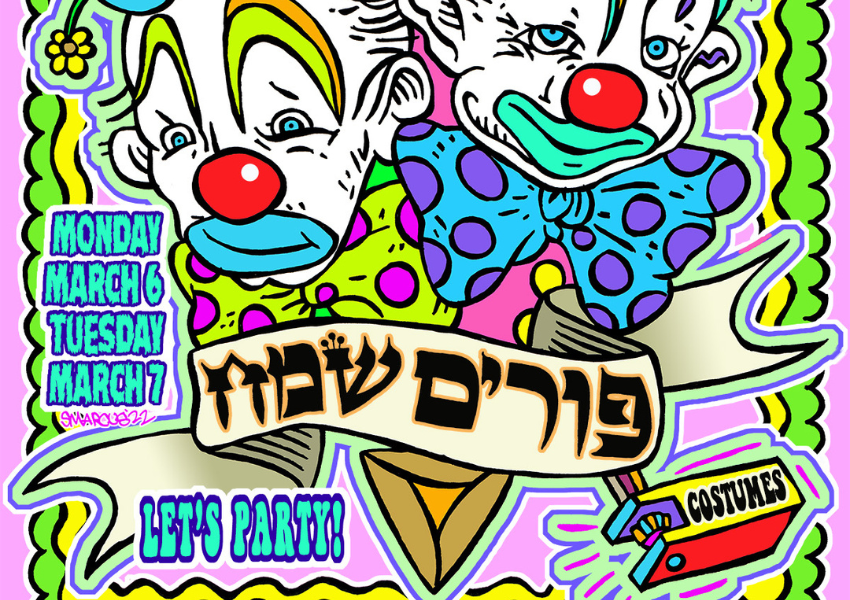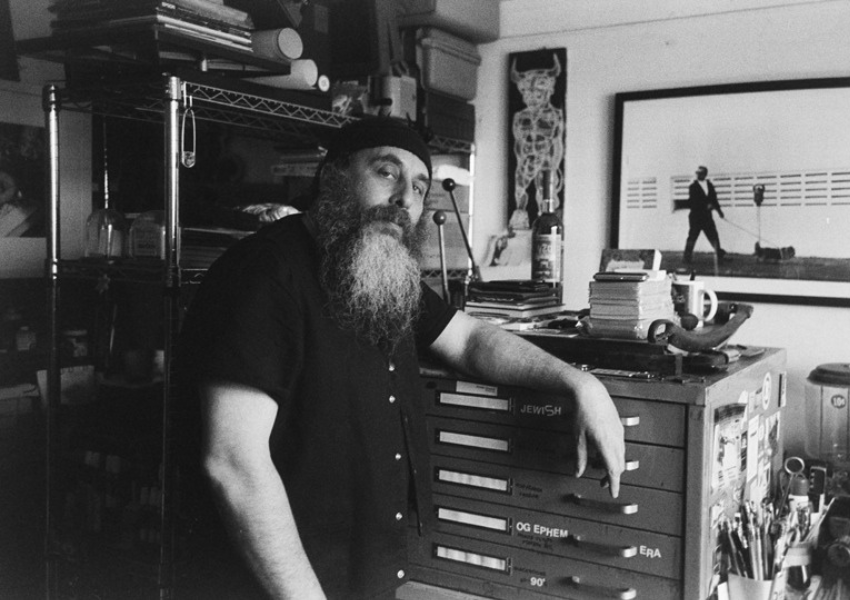Purim Poster

Purim, like Hanukkah, is a Jewish Holiday that was instituted by the Rabbis to commemorate the saving of the Jewish people from Haman, an official of the Achaemenid Empire and royal advisor to the Persian King Ahasuerus. Haman plotted to have all of the Jews in Persia (modern day Iran) murdered, as recounted in the Book of Esther in the 5th century BCE. Haman’s plans were foiled by Mordechai of the Tribe of Benjamin and Esther, Mordecai’s cousin and adopted daughter, who become the Queen of Persia after her marriage to Ahasuerus. The day of Haman’s foiled plot became a day of feasting and rejoicing among the Jewish people.
Purim is celebrated among Jews by exchanging gifts of food and drink, dressing in costumes, going to parties, getting drunk, donating charity to the poor, having a festive meal, and the public recitation of the Scroll of Esther.
When Haman’s name is read out loud, which occurs 54 times during the public chanting of the Book of Esther, commonly known as the Megillah, the synagogue congregation engages in noise making to blot out his name. This practice can be traced back to the Tosafists, who were the leading French and German rabbis of the 13th century, in accordance with a passage in the Midrash, where the verse says “Thou shalt blot out the remembrance of Amalek.” Amalek is the eternal enemy of the Jewish people and one is obligated to destroy Amalek as taught in the Torah.
Haman is the offspring of Amalek, and a custom developed of writing the name of Haman on two smooth stones and knocking them together until the name was blotted out. Some wrote the name of Haman on the soles of their shoes, and at the mention of the name, stomped with their feet as a sign of contempt. The most common method is to use a noisy rachet called a grogger, used to make noise to blot out the name of Haman during the reading.
In the Megillah, G-d’s name is never mentioned, but there are a series of coincidences that deliver the Jewish people to victory. These coincidences are understood and known to have been guided by divine intervention. Gematria is the assignment of numerical values for Hebrew letters, and the numerical value of Amalek is equal to the Hebrew word for “doubt”, suggesting that the true spiritual enemy of the Jewish people is doubt and our lack of faith in divine providence. So, when you’re eating your hamantaschen and using your grogger at the mention of Haman’s name, you’re also blotting out any doubt that could have about who really has control over the world.
Chag Purim Sameach! Freilechen Purim!
— Reb Simcha Yosef ben Yehuda Ha’Levi
AKA Steve Marcus, Artist
Purim Poster (close up 1)

Purim Poster (close up 2)

About the Poster Series

NYC Artist, Steve Marcus writes about his new series for the Jewish Arts Collaborative:
“There’s an old saying that a skilled laborer works with their hands, a craftsman with their hands and mind, but an artist works with their hands, mind, and heart. This trinity of the hands, mind, and heart is accessible for artistic manifestation by any human being, regardless of race, religion, ethnicity, sexual orientation, or gender. Within the mind-boggling diversity of the human population and its countless artists— now capable of tracing their ancestors’ origins to every corner of the globe— one may wonder, what makes art “ethnic”?
Ethnic art incorporates and expresses a specific people’s culture, history, and collective experience. When artisans and their work are both descended from a specific group’s said collective experience, and the artisan chooses to wrestle with the inner torment of the group’s reality with the hope of communicating the subtleties of their unique daily experience and thought processes, the subject of the work becomes the artisans themselves. The work can then be considered authentic “ethnic art”. However, not all art crafted by the hands of ethnic artisans can be classified as ethnic art. When craftspersons of distinct ethnicities create objects without ethnic content, the “ethnic” adjective refers to the artist and not the art. And if an artisan creates art that has ethnic content relating to an ethnicity that is not their own, then the ethnic adjective refers to the art and not the artisan. In this case, the artisan may be knowledgeable of the subject matter, so the art may mimic ethnicity, but it will not be informed by an authentic experience. The exploitation of that inner experience by someone from a separate culture amounts to “cultural appropriation”.
In the era of globalization, the ugliness of cultural appropriation has become rampant, as various “outside cultures” are now easily accessible with the assistance of the internet and social media. The digital-age specter of colonialism, imperialism and social Darwinism disseminates information and imagery at a dystopian pace. Consumers hijack distant cultures’ attitudes and style cues to mold themselves into the hipster approximations of cultures they have never experienced firsthand. This form of imitation is the stylistic manifestation of colonial imperialism and is helping to pave a bland and blind path toward a global monoculture.
Many descendants of the founders of monotheism are suckers for the global monoculture—no longer a nation within a nation, they are being absorbed into the matrix. The greatest existential threat to the Jewish people is the Jewish people themselves. The apologetic and sometimes dismissive attitude Jews have about being Jewish, to the point of assimilation, has left most Jewish artists and institutions struggling through a postmodern identity crisis. They’ve abandoned so much of their own intrinsic identity, creating art that begs for acceptance from their own tormentors. This current series of work for the Jewish Arts Collaborative expresses my own roots and culture by creating images for the annual festivals, holidays, and observances of the Jewish calendar, which proudly contain Jewish values as a celebration of authenticity. However, the artwork is not just a creative declaration of my own identity and beliefs but also created to inspire all people to celebrate and explore their own true identities in a creative rebellion that smashes falsehood and hatred. The quest for the truth will lead to oneness. Be strong and may we be strengthened.”
Steve Marcus (aka smarcus) has received honors and awards from the American Society of Illustrators and has several works in the art and American history collections in esteemed institutions, notably the Oakland Museum of California, The Jewish Museum of Florida – FIU, The Yiddish Book Center, The Harvard Library, Yivo Institute for Jewish Research and The Miami-Dade PLS. He is acknowledged as one of the Lower East Side’s most culturally influential residents in, “Jews: The People’s History of the Lower East Side” and his work is written about by professors from Ohio State University, Tulane University, Florida State University, Harvard University and in scholarly books published by Duke University Press, The University of Texas Press and the Florida International University. Steve is a member of the American Guild of Judaic Art.
This work was commissioned by the Jewish Arts Collaborative in 2022.
Other posters in this series: Tu BiShvat, Hanukkah, Passover. Stay tuned for more.
(Above: Photo by Ziggy York)
JArts’ mission is to curate, celebrate, and build community around the diverse world of Jewish arts, culture, and creative expression. Our vision is of a more connected, engaged, and tolerant world inspired by Jewish arts and culture.
Reflections
Jewish Halloween?
In the U.S., some Jews refer to Purim as "Jewish Halloween" and dress up in costumes beyond the characters in Esther's story. In what other ways is Purim similar to Halloween and what makes it different? Would it be appropriate for non-Jews to celebrate "Jewish Halloween"?
Assimilation
One of the central ideas of this series is a grappling with assimilation and the abandonment of identity. How does the artist’s work embody authenticity and “creative rebellion”?
“Ethnic art”
What do you think makes a piece of art “ethnic”? How do you define “Jewish art”?
Want more?
Get curated JewishArts.org content in your inbox



